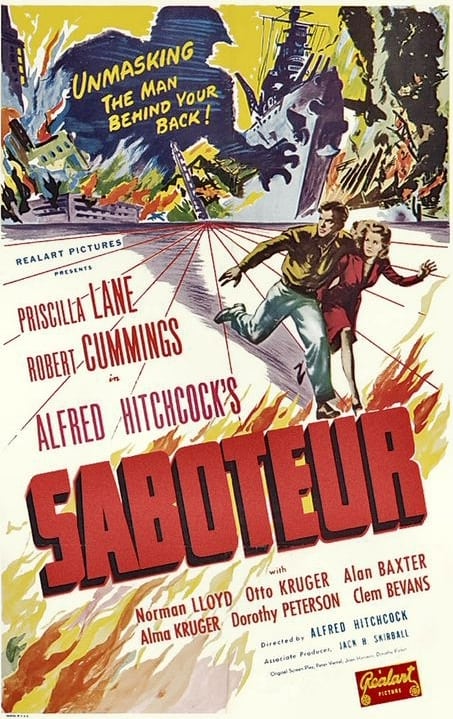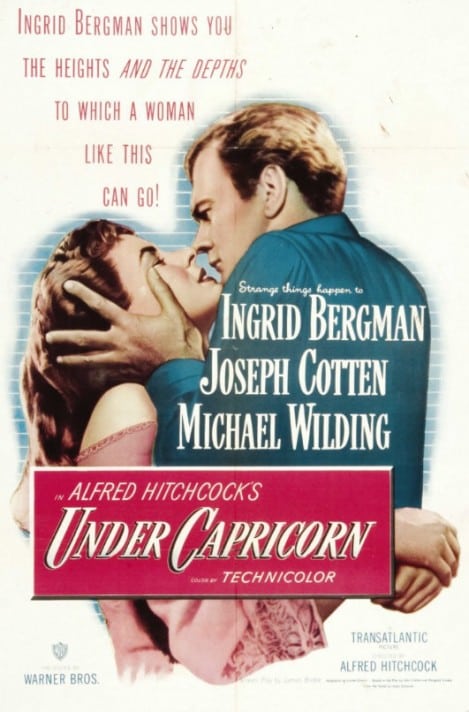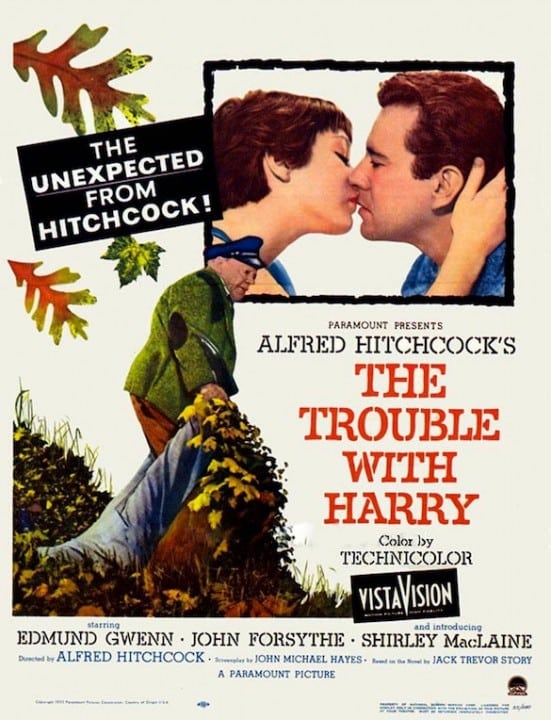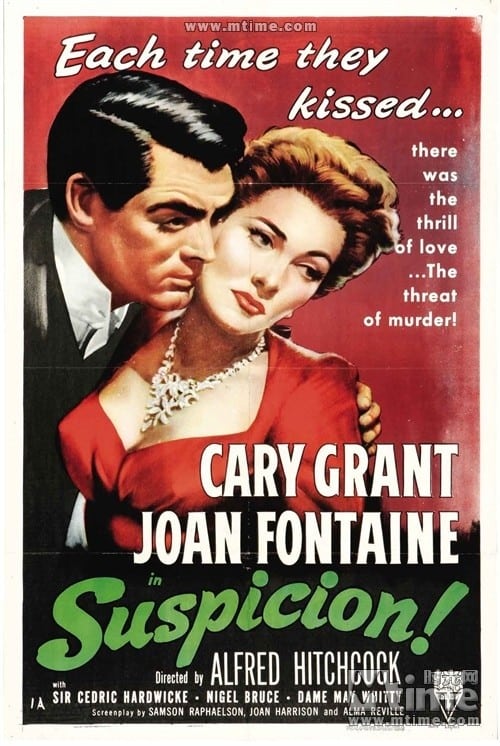Saboteur (1942)
Directed by: Alfred Hitchcock
Written by: Dorothy Parker, Joan Harrison, Peter Viertel
Starring: Alan Baxter, Otto Kruger, Priscilla Lane, Robert Cummings
USA
RUNNING TIME:109 min
AVAILABLE ON DVD
THE HITCHCOCK CAMEO: at a New York news-stand, standing just behind the taxi car carrying Barry Kane that pulls up in front of the Cut Rate Drugs shop window.
REVIEWED BY: Dr Lenera, Official HCF Critic
Someone starts a fire at a Glendale, California airplane plant, an act of sabotage that kills several people. Worker Barry Kane believes the culprit is a man named Fry who handed him a fire extinguisher filled with gasoline during the fire, but when the investigators find no one named “Fry” on the list of plant workers, they assume Barry is guilty. Barry remembers he saw Fry’s name on an envelope he dropped before the fire, so he heads to the address, a ranch in the desert, where the owner appears to be a well-respected citizen, but is working with the saboteurs. Barry reads mail revealing Fry has gone to Soda City, but first Barry has to escape from the police, who have been called by the ranch owner, before he can resume his search….
The Man Who Knew Too Much is generally considered to be the only one of Hitchcock’s films that he remade, but you could really make a strong case for Saboteur for being a remake of The 39 Steps. Though the ideas of a man on the run and a man accused of a crime he didn’t commit recur throughout Hitchcock’s work, Saboteur has many scenes which are almost identical to the 1935 film like the hero confronting the chief villain in his house and being told, “I’m a respectable citizen, I’m widely known”, the hero escaping police in his handcuffs, and the hero having to give a public speech. Along with bits and pieces from other films like a Young And Innocent-type tracking shot across a crowded room to reveal the villain has a disability [here, a finger missing], a gun peering out from a curtain a la The Man Who Knew Too Much, and a Sabotage-like scene in a cinema where the action on screen is used as ironic counterpoint to what is occurring off it, there is a distinct sense of the director rehashing things from his British work. Like with his previous movie Suspicion, Hitchcock seems to be coasting somewhat, though Saboteur is a better movie than that. It’s rather baggy compared to the air-tight The 39 Steps, and is basically on the same level as Foreign Correspondent, which also had villainous [if unnamed] Nazis and a bit of propaganda: immense fun, and rarely dull, but falling short of greatness.
Hitchcock considered remaking The Lodger and The Man Who Knew Too Much while Suspicion’s production was being delayed, then was originally intended to make Saboteur for David O. Selznick with Gene Kelly starring after Hitchcock, Michael Hogan and Joan Harrison submitted their first treatment. However, Selznick sold it to the Frank Lloyd Productions [working under Universal], producer and director falling out over Selznick’s huge fees for loaning Hitchcock out and Hitchcock not spending enough time in his office. Hitchcock’s seven-year collaborator Harrison also left, and first-time screenwriter Peter Viertel ended up writing the actual script, which would be spiced up with contributions from that great wit Dorothy Parker. Hitchcock wanted Gary Cooper and Barbara Stanwyck to star, but ended up with the more ‘B’ level Robert Cummings and Priscilla Lane. He also wanted Harry Carey and Florence Bates as the two main villains, but this was scuppered too and Otto Kruger and Alma Kruger [no relation] played the roles. In fact Saboteur was a considerably cheaper production than the last four films, though it had more extensive location shooting than usual. Hitchcock’s original cameo was cut by order of the censors. He and his secretary played deaf-mute pedestrians. When Hitch’s character made an apparently indecent proposal to her in sign language, she slapped his face. During final editing, Hitchcock added actual newsreel footage of a mysteriously destroyed ocean liner as the work of the saboteur. The navy objected at what they saw as an implication that the ship had been sabotaged, and some versions of the film had the shots removed. Saboteur was the usual commercial and critical hit, if not so much as was becoming the norm.
Saboteur wastes no time getting down to it. After a strong title sequence where the shadow of a man gets closer and closer [maybe this inspired the start of Double Indemnity?], there’s a very brief introduction to the workers in the factory before we have a great shot of a wall into which black smoke seeps in from the right-hand side of the screen, looking for all the world like The Blob. This is followed by a rather shocking shot of Barry’s friend collapsing while engulfed in flames. Barry visits the dead man’s widow, then follows a clue to a ranch and a recapitulation of a sequence from The 39 Steps where the hero confronts the villain and the latter calls the police, though it occurred much later in that film, and the 1935 movie didn’t have the hero being lassoed by cowboys on horses! Barry does a memorable dive from a bridge to escape the police, and there’s a good chase in the studio-bound [but quite good] waterfall beneath. Hitchcock’s [or the writer’s] influences seem to be very wide with this movie, as we now get a scene where Barry visits a blind old man who plays the piano, a scene which is extremely similar to the famous bit in Bride Of Frankenstein where the Monster briefly finds friendship with a violin-playing hermit. Saboteur then proceeds to cover a lot of ground as Barry finds himself stuck with a woman who can’t wait to turn him in, is chased again, finds arrives in a ghost town, pretends to join the bad guys and ends up with them in New York, though the pace isn’t as fast as descriptions make it sound, and it only gets really tense with the famous scene where hero and heroine are trapped on a dance floor surrounded by bad guys, which is not only extremely suspenseful but full of romantic intensity.
Saboteur takes pains to show various folk helping Barry out, perhaps trying to get the viewing public behind the war effort. It’s pretty ridiculous that so many people take Barry’s word for it that he’s innocent, though he does tend to go on about liberty and freedom in a way perhaps jarring to modern viewers who just have to remember that America was still not in the World War 2 [this would change two days after the film’s release with the bombing of Pearl Harbour]. You can often tell Parker’s contributions to the script, because some lines stand out as being humorous in a generally reasonably serious [if undeniably silly] film. I especially like some funny uses of the real saboteur’s name, from Fry actually frying somebody to Patricia saying how, “That Fry seems so small”. Most notably, Parker contributed a scene which seems out of place but is very memorable [and maybe inspired by Freaks]. The couple board a train which is inhabited by circus freaks. A midget opens the door but the couple can’t see anyone till they look down. A thin man and the midget keep rowing, as bearded lady has her hair in curlers for the night, and Siamese twins communicate through a third person, one saying, “I wish you’d tell her to do something about her insomnia, I do nothing but toss and turn all night”. Very funny but also full of sympathy for these outcasts, it’s a strange but unforgettable sequence. There’s also a nice use of irony throughout [“Easy to see there’s nothing on your mind” says someone to Barry] in a film where hardly anything is as it seems.
Despite its many noteworthy aspects which do go some way to justifying what is largely a rehash, Saboteur is sometimes a little sloppy and even nonsensical. I’m not referring so much to the plot, which is full of nice elements [a whole gang of Fifth Columnists headed by a society dame!], but to scenes like where Patricia rests her head on Barry’s shoulder because she’s cold. Huh? As the film moves to its climax, Barry is trapped in a room and we see that he’s about to start a fire, but we don’t actually see how he got out. There’s also an unintentionally funny bit where Barry is choking the saboteur to death and the latter far too calmly tells his mate to go off and carry on the mission. The mixing of location footage with set shots, along with extensive use of matte paintings is quite well done though. The Statue Of Liberty climax, where the threads on the hanging villain’s jacket come apart [and how often has this been copied?], is more atmospheric than thrilling, but the fall is remarkably convincing. Actor Norman Lloyd lay on his side on a black saddle on a black floor while the camera was hauled from close-up to 40 feet above him. Film taken from the top of the Statue was then superimposed onto the black background, making him appear to drop downward, away from the camera.
Robert Cummings and Priscilla Lane are okay in the lead roles and nothing more, the stand-out performers being more in smaller roles like Norman Lloyd as Fry, especially good in a scene where Patricia is trying to keep him at the top of the Statue of Liberty and he’s obviously attracted to her but gets more and more suspicious. Joseph Valentine’s cinematography is full of vivid blacks and almost has a film noir quality, while Frank Skinner’s score works well despite it being, apart from some action material, mostly based on one theme which seems to be for both saboteurs in the film, the real one and Barry, the one who the police think is one. It opens the film really menacingly, adopts a Western feel for the ranch locale, is turned into a sweet love theme and even a waltz, and closes the movie as a rousing march. Saboteur has been perhaps rightly overshadowed by The 39 Steps and the later and very similar North By Northwest , sandwiched chronologically as it is between those two, and compared to them it’s undeniably minor, but it has many pleasures and holds up well today as a thoroughly enjoyable escapist thriller.
Rating: 

















Be the first to comment